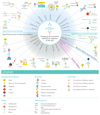p24 revisited: a landscape review of antigen detection for early HIV diagnosis
- PMID: 30102659
- PMCID: PMC6139023
- DOI: 10.1097/QAD.0000000000001982
p24 revisited: a landscape review of antigen detection for early HIV diagnosis
Abstract
: Despite major advances in HIV testing, early detection of infection at the point of care (PoC) remains a key challenge. Although rapid antibody PoC and laboratory-based nucleic acid amplification tests dominate the diagnostics market, the viral capsid protein p24 is recognized as an alternative early virological biomarker of infection. However, the detection of ultra-low levels of p24 at the PoC has proven challenging. Here we review the landscape of p24 diagnostics to identify knowledge gaps and barriers and help shape future research agendas. Five hundred and seventy-four research articles to May 2018 that propose or evaluate diagnostic assays for p24 were identified and reviewed. We give a brief history of diagnostic development, and the utility of p24 as a biomarker in different populations such as infants, the newly infected, those on preexposure prophylaxis and self-testers. We review the performance of commercial p24 assays and consider elements such as immune complex disruption, resource-poor settings, prevalence, and assay antibodies. Emerging and ultrasensitive assays are reviewed and show a number of promising approaches but further translation has been limited. We summarize studies on the health economic benefits of using antigen testing. Finally, we speculate on the future uses of high-performance p24 assays, particularly, if available in self-test format.
Figures




Similar articles
-
Point-Of-Care p24 Infant Testing for HIV May Increase Patient Identification despite Low Sensitivity.PLoS One. 2017 Jan 6;12(1):e0169497. doi: 10.1371/journal.pone.0169497. eCollection 2017. PLoS One. 2017. PMID: 28060886 Free PMC article.
-
A click chemistry amplified nanopore assay for ultrasensitive quantification of HIV-1 p24 antigen in clinical samples.Nat Commun. 2022 Nov 11;13(1):6852. doi: 10.1038/s41467-022-34273-x. Nat Commun. 2022. PMID: 36369146 Free PMC article.
-
Comparison of Detection Limits of Fourth- and Fifth-Generation Combination HIV Antigen-Antibody, p24 Antigen, and Viral Load Assays on Diverse HIV Isolates.J Clin Microbiol. 2018 Jul 26;56(8):e02045-17. doi: 10.1128/JCM.02045-17. Print 2018 Aug. J Clin Microbiol. 2018. PMID: 29793968 Free PMC article.
-
Measurement of HIV-1 p24 antigen by signal-amplification-boosted ELISA of heat-denatured plasma is a simple and inexpensive alternative to tests for viral RNA.AIDS Rev. 2002 Apr-Jun;4(2):83-92. AIDS Rev. 2002. PMID: 12152521 Review.
-
[Screening tests combined with p24 antigen and anti-HIV antibodies in early detection of HIV-1].Transfus Clin Biol. 2000 Jun;7 Suppl 1:18s-24s. doi: 10.1016/s1246-7820(00)80011-7. Transfus Clin Biol. 2000. PMID: 10919219 Review. French.
Cited by
-
HIV Capsid Protein Genetic Diversity Across HIV-1 Variants and Impact on New Capsid-Inhibitor Lenacapavir.Front Microbiol. 2022 Apr 12;13:854974. doi: 10.3389/fmicb.2022.854974. eCollection 2022. Front Microbiol. 2022. PMID: 35495642 Free PMC article.
-
The Standardization and Control of Serology and Nucleic Acid Testing for Infectious Diseases.Clin Microbiol Rev. 2021 Dec 15;34(4):e0003521. doi: 10.1128/CMR.00035-21. Epub 2021 Jul 28. Clin Microbiol Rev. 2021. PMID: 34319148 Free PMC article. Review.
-
Developments in Exploring Fungal Secondary Metabolites as Antiviral Compounds and Advances in HIV-1 Inhibitor Screening Assays.Viruses. 2023 Apr 23;15(5):1039. doi: 10.3390/v15051039. Viruses. 2023. PMID: 37243125 Free PMC article. Review.
-
Identification and characterization of linear epitopes of monoclonal antibodies against the capsid proteins of small ruminant lentiviruses.Front Microbiol. 2024 Aug 1;15:1452063. doi: 10.3389/fmicb.2024.1452063. eCollection 2024. Front Microbiol. 2024. PMID: 39149208 Free PMC article.
-
Point of care testing for infectious diseases.Clin Chim Acta. 2019 Jun;493:138-147. doi: 10.1016/j.cca.2019.03.008. Epub 2019 Mar 8. Clin Chim Acta. 2019. PMID: 30853460 Free PMC article. Review.
References
-
- UN General Assembly. Political Declaration on HIV and AIDS: On the Fast-Track to Accelerate the Fight against HIV and to End the AIDS Epidemic by 2030. 2016
-
- UNAIDS. Fast Track: Ending the AIDS epidemic by 2030. 2014
-
- UNAIDS. 90-90-90: An ambitious treatment target to help end the AIDS epidemic. 2014
-
- World Health Organization. Consolidated guidelines on HIV testing services. 2015
Publication types
MeSH terms
Substances
Grants and funding
LinkOut - more resources
Full Text Sources
Other Literature Sources
Medical

